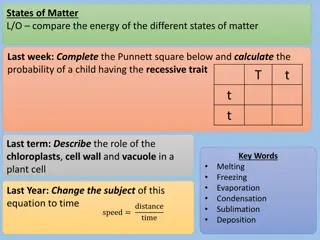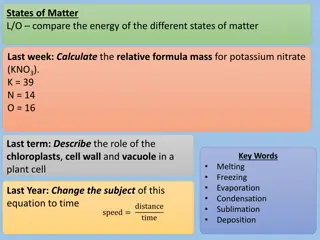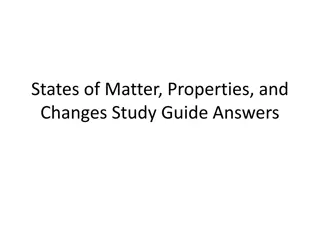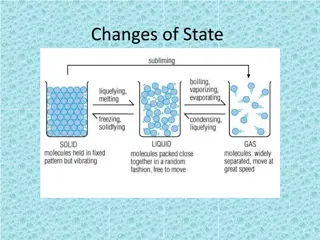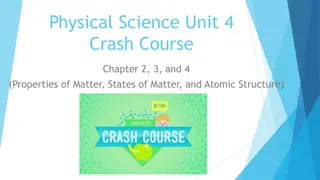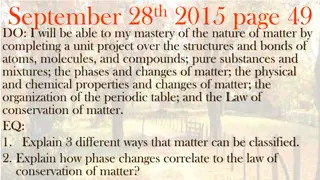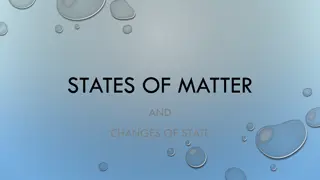Understanding Matter: States, Properties, and Changes
Matter is anything with mass and volume, existing in solid, liquid, or gas states. The Kinetic Molecular Theory explains the behavior of particles in matter. Chemistry explores matter through chemical and physical changes. Different factors, like temperature, can change the state of matter. Physical properties of matter include qualitative and quantitative characteristics. Explore the fascinating world of matter and its properties.
Download Presentation

Please find below an Image/Link to download the presentation.
The content on the website is provided AS IS for your information and personal use only. It may not be sold, licensed, or shared on other websites without obtaining consent from the author. Download presentation by click this link. If you encounter any issues during the download, it is possible that the publisher has removed the file from their server.
E N D
Presentation Transcript
Matter Matters JAN REGACHO/JOSEPH KIM
What is Matter? Matter is anything that has mass and volume Solid, Liquid, and Gas are the three states of Matter
What is the Kinetic Molecular Theory? This theory describes how changes in the kinetic energy of particles can result in changes of state This theory also helps explain the difference between solids, liquids, and gases It explains what happens to matter when the kinetic energy of particles changes Main points of kinetic molecular theory are: All matter is made up of very small particles There is empty space between particles Particles are constantly moving Energy makes particles move
What is chemistry? Chemistry includes facts and observations about matter. Chemistry involves changes such as Chemical and Physical change Chemical change is a change in matter that occurs when substances combine to form new substances Physical change is when appearance of substance may change, but the chemical substance remains the same and that no new substances are formed
How does the states of Matter change? There are a number of factors that could change the state of Matter such as temperature. If a solid such as an ice cube was put in a location with an inconsiderable amount of heat, the ice cube s state will change into liquid(water). This is called melting. If a liquid such as water were to experience an immense amount of heat, the water will turn into gas(steam). This is called evaporation. If a liquid such as water was left inside a refrigerator for a long time, the water will turn into a solid(ice cube). This is called Freezing. These are one of the ways that temperature can change the state of Matter.
What are the Physical Properties of Matter? QUALITATIVE PROPERTIES QUANTITATIVE PROPERTIES Qualitative Properties can be described but not measured such as: Quantitative Properties can be measured with numbers such as: State- solid, liquid, gas Solubility- the ability to dissolve in water Colour- colour Conductivity- the ability to conduct heat or electricity Malleability- the ability to be bent into sheets Viscosity- the resistance to flow Ductility- the ability to be drawn into wires Density- the ratio of a material s mass to its volume Crystallinity- the shape or appearance of a crystal Melting/Freezing point- the temperature of melting/freezing Magnetism- the tendency to be attracted to a magnet Boiling/Condensing point- the temperature of boiling/condensing





